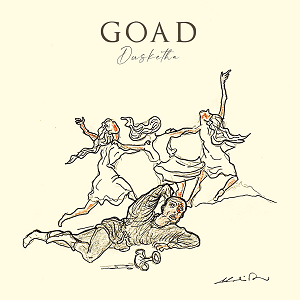There’s very little time left until the release of “Dusketha,” the new album by GOAD, veterans of the Italian Progressive Rock scene, out this Friday, October 10th.
The band present the second track taken from the album, “Yes It Was Love (Message From A Cathedral),” whose video is available via the YouTube player below:
Available as a double CD and in digital format, “Dusketha” represents a true musical journey, rich in captivating nuances. It features 18 tracks and nearly two hours of pure art, giving voice to the breath of lost poetry, where every note becomes a fragment of eternity.
The driving force and soul of the band, Maurilio Rossi, once again draws inspiration from the great Anglo-American poets — Keats, Poe, Lovecraft, Masters, and Graham. After more than fifty years of career, he still manages to surprise us, and does so in the most sublime way possible.
GOAD — the living history of Italian Progressive Rock!
Purchase “Dusktha” here: https://mykingdommusic.bigcartel.com/product/goad-dusketha-2cd
Tracklist:
Disc 1
1. Yes It Was Love (Message From A Cathedral)
2. One Of These Days (Is There Still Day)
3. Alone Man In Empty Room
4. Poor Skull (Reverend Brothers)
5. Daisy’ Rock
6. To An After Time My Harmonies
7. And Still We’ll Dance Into The Light Of Heaven
8. My Feet In The Breaking Wave Sundown
9. Give It Not A Tear
Disc 2
1. Stop And Consider Life Is But A Day
2. While I Kiss To The Melody (Night Sleepy Eyes)
3. Hush My Love (Lullaby For A Woman)
4. The Speed Of My Nightmares
5. Let Out Song
6. Finally Remembering I’m Dead
7. Garden With Spectral Gleams
8. Foxsteps On My Nylon Guitar
9. The Woodkeeper, A Collar Of Red (bonus track)
This is what Maurilio Rossi wanted to share with us about the creative journey that led to the birth of his new work:
“Dusketha represents for me a kind of sonic ritual between poetry and shadow — the sound of an inner twilight, where poetry merges with unconventional harmonies and sometimes visionary arrangements.
The primordial idea for this album dates back as far as 1993. Through it, I tried to give voice and sound to the original texts by John Keats, Edgar Lee Masters, H.P. Lovecraft, E.A. Poe, Jorie Graham, and others.To achieve this, I sought a warm and vibrant tone, and after various experiments — supported by Max Cirone and his great experience — we came to the conclusion that we needed to return to “ancient” tools and production methods, such as the use of Maxell UD 25-120 magnetic tape and the Akai GX4000D recorder, as well as employing the classic tape bounce technique to give everything a truly vintage aesthetic.
The result, I must admit, was surprising, and I am convinced that those who listen to it will be transported into a deep and immersive experience — something that happens only rarely.*”
